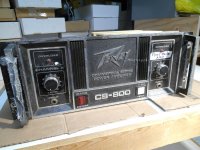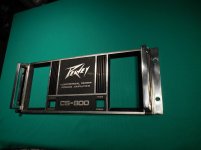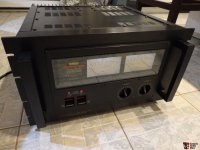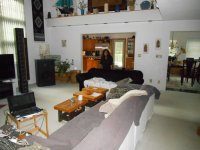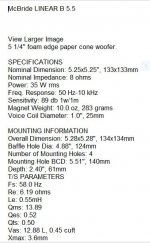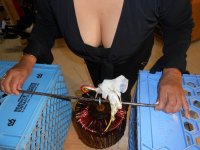Hi Folks;
I am back to my revival of this old Peavey CS800. It has had a tough life but just seems like a worthwhile project. I was surprised that the functioning channel developed 330 watts in 8 ohms. The specs are very under-rated 280 watts. I have broached this subject in the tail end of my last thread (304403-pet-peeve-peavey-gps-3500).
I have found a couple of simple upgrades, here at diyaudio, for this amp. Additionally, I hope to eventually install a temperature sensing fan controller (robbed from a deceased Beta800 amp, possibly) and have the fan switch between variable and full.
I have some ON Semi MJ21196 outputs on order from Hong Kong ( Yikes?!!)
I have installed these in my Phase Linear 700B, so in the interest of uniformity, I thought I would use them here, I am hoping they are a good replacement for the MJ15024, if not even a little better?
I appreciate any input regarding this rebuild, as I am only a hobbiest, but hope to gain some knowledge. I suspect that this is a good candidate for beginners, as it does not seem nearly as complex as many amps in this power range. I understand that there are a lot of these amps around, but they had to be popular for a reason!
I am back to my revival of this old Peavey CS800. It has had a tough life but just seems like a worthwhile project. I was surprised that the functioning channel developed 330 watts in 8 ohms. The specs are very under-rated 280 watts. I have broached this subject in the tail end of my last thread (304403-pet-peeve-peavey-gps-3500).
I have found a couple of simple upgrades, here at diyaudio, for this amp. Additionally, I hope to eventually install a temperature sensing fan controller (robbed from a deceased Beta800 amp, possibly) and have the fan switch between variable and full.
I have some ON Semi MJ21196 outputs on order from Hong Kong ( Yikes?!!)
I have installed these in my Phase Linear 700B, so in the interest of uniformity, I thought I would use them here, I am hoping they are a good replacement for the MJ15024, if not even a little better?
I appreciate any input regarding this rebuild, as I am only a hobbiest, but hope to gain some knowledge. I suspect that this is a good candidate for beginners, as it does not seem nearly as complex as many amps in this power range. I understand that there are a lot of these amps around, but they had to be popular for a reason!
Attachments
I am back to my revival of this old Peavey CS800.
This is often just as effective as replacing parts with contacts, like pots and switches.
CAIG DeoxIT D5S-6 Spray 5 oz. with Perfect Straw
They were popular *because* the output transistors rarely failed (unlike the PL). They would also put out 280 watts out of both channels driven at the same time at 8 ohms, which is why you could get 330 out of just one. And it could do that with sine waves for hours at a time, cheaper amps would thermal after a few minutes. You could run about 50-60% duty cycle at 4 ohms, which is still a heavier load than most hip hop. They claim to not be 2 ohm capable, but by today’s standards they are more rugged than amps rated to 2.
Similarly rated amplifiers today would be good for 50 watts of average power per channel at 4 ohms and no more, with the peaks of the waveform hitting 56 volts. And still be called 400 RMS per channel at 4 ohm.
Similarly rated amplifiers today would be good for 50 watts of average power per channel at 4 ohms and no more, with the peaks of the waveform hitting 56 volts. And still be called 400 RMS per channel at 4 ohm.
The output transistors rarely fail. If they have, it will be obvious!
Contacts and electrolytics are all that sometimes need attention.
Personally, they make good door stops!
I'll have to agree.... a door stop at best.
Not a commercial piece or a Pro Sound piece.
Something suited for the wanabe JD or weekend musician.
So many golden eared posters listening to 300 W amps with earphones. With real speakers at >20 W the difference between .0003% HD and .5% HD is IMHO inaudible. And most American males don't have hearing above 7000 hz anyway. Mine goes to 14khz. I have my doubts about the revision A with single op amp (5478?) and 8 predriver transistors, but later versions with the 4558 should sound as good as my PV1.3k at lower volumes. and the 4558 could easily be swapped out for a 33078 or RC4580. I used MJ21193/94 from Newark for my rebuild. People that don't believe blown outputs are common on the resale market have never set up a band in the dark on stage with 1/4 phone plugs for speakers, mixer to amp cable, guitar amp outputs and pickups, mike outputs, which cord is this? Whoops the vocalist tripped! SHORT! Speakons weren't invented til later and no amateur band ever bought them. Shorted speaker drivers aren't that unusual in stage bands, either. Swapping out the whole driver board is not impossible either. The KKR connectors are still available. But one thing at a time, get it working with the original drivers IMHO. Small transistors are not picky, I used MPS8099 npn and MPSA56 in the pnp TO92 ones, MJE15032-33 in the TO220's. For less work for great sound, CS800x hulks are down to $100 these days. These should sound as great as my CS800s after the road damage is repaired. X versus S is the elimination of a 30 lb transformer in the S, a big disavantage on the road for the X.
Last edited:
Hi Folks!
I seem to have generated some attention with what I thought was a mundane project. I consider this amp to be like a '57 chevy, not a Ferrari or Cadillac, but too nice for the scrap heap. I do have a Backyard system with 4 Cerwin-Vega 18" cabinets of about the same vintage, which the amp would be perfect for.
Hi Jon and Burnedfingers; At least at the end of this, I might have a shiny, multi-purpose doorstop!
Hi Rayma; I saw "Deoxit" at a shop in Barrie, Ontario. It was about $30 for a 5 oz can. I found a cheaper product, which so far, has also proven to be effective...I thought it would be cheaper to replace the pot, than spray it which a $30 can of contact cleaner! (kidding--maybe).
Hi wg-ski; Thanks for the words of encouragement, all that aluminum heat sink, power trans, the giant filter cans, and it's BGW 750 layout; I think it's a keeper!
Hi Michael; Is converting an amp to full complimentary, an expensive mod? Would it require completely new driver boards? I would like to know more about that conversion, are there after market or Peavey boards, if required? Also, thanks for the warning re: transformer buzz. I am using a Crest CA18 (1000 W/ch into 8 ohms) to drive my LF cabinets in my home theatre. I wanted that explosive punch, but after replacing the fans with slower, quieter units, the noisy torroid was a huge set-back. 20 dips in electrical varnish, 5 days over a heat lamp between dips and now this beast is dead quiet.
Hi Indianajo; Thanks again for your extensive response! I am looking forward to taking full advantage of your experience, once I get into the "thick of it". I remember holding up my nose at a CS800, in the late 70's, because of the hiss and noise. Of course, I was listening to this amp at a shop that was repairing my Phase Linear 700. My Phase was particularly quiet at that moment because it had 3 shorted outputs, smoked one of my JBL woofers and just cooked one of the Service-tech's test speakers!
I'm hoping this thread will be of interest to many, because so many of these amps are still kicking around. I will try to avoid repetition, but I really appreciate the contribution of all the relevant CS800 mods.
Attached photo; I was just 'doodling' with the cosmetics, while waiting for my outputs to arrive. Never-mind matching! the old outputs weren't even the same types.
I seem to have generated some attention with what I thought was a mundane project. I consider this amp to be like a '57 chevy, not a Ferrari or Cadillac, but too nice for the scrap heap. I do have a Backyard system with 4 Cerwin-Vega 18" cabinets of about the same vintage, which the amp would be perfect for.
Hi Jon and Burnedfingers; At least at the end of this, I might have a shiny, multi-purpose doorstop!
Hi Rayma; I saw "Deoxit" at a shop in Barrie, Ontario. It was about $30 for a 5 oz can. I found a cheaper product, which so far, has also proven to be effective...I thought it would be cheaper to replace the pot, than spray it which a $30 can of contact cleaner! (kidding--maybe).
Hi wg-ski; Thanks for the words of encouragement, all that aluminum heat sink, power trans, the giant filter cans, and it's BGW 750 layout; I think it's a keeper!
Hi Michael; Is converting an amp to full complimentary, an expensive mod? Would it require completely new driver boards? I would like to know more about that conversion, are there after market or Peavey boards, if required? Also, thanks for the warning re: transformer buzz. I am using a Crest CA18 (1000 W/ch into 8 ohms) to drive my LF cabinets in my home theatre. I wanted that explosive punch, but after replacing the fans with slower, quieter units, the noisy torroid was a huge set-back. 20 dips in electrical varnish, 5 days over a heat lamp between dips and now this beast is dead quiet.
Hi Indianajo; Thanks again for your extensive response! I am looking forward to taking full advantage of your experience, once I get into the "thick of it". I remember holding up my nose at a CS800, in the late 70's, because of the hiss and noise. Of course, I was listening to this amp at a shop that was repairing my Phase Linear 700. My Phase was particularly quiet at that moment because it had 3 shorted outputs, smoked one of my JBL woofers and just cooked one of the Service-tech's test speakers!
I'm hoping this thread will be of interest to many, because so many of these amps are still kicking around. I will try to avoid repetition, but I really appreciate the contribution of all the relevant CS800 mods.
Attached photo; I was just 'doodling' with the cosmetics, while waiting for my outputs to arrive. Never-mind matching! the old outputs weren't even the same types.
Attachments
Wow, non part # match outputs. What a repair pro! I tried that once.Hi Folks!
I remember holding up my nose at a CS800, in the late 70's, because of the hiss and noise. Of course, I was listening to this amp at a shop that was repairing my Phase Linear 700. My Phase was particularly quiet at that moment because it had 3 shorted outputs, smoked one of my JBL woofers and just cooked one of the Service-tech's test speakers!
while waiting for my outputs to arrive. Never-mind matching! the old outputs weren't even the same types.
Those old 70's-80's op amps hissed like a steam engine, and the
4558 used in later cs800 is not great. I knocked 10 db hiss, maybe more, out of a disco mixer by changing from 4558 to 33078, plus a 22 pf bypass cap around the feedback resistor and a .1 uf ps bypass cap 2" from the IC. (both IC's actually, one .1 cap two op amp IC's.) Otherwise the fast 33078 oscillated about 1 mhz.
If you have the sc5278 op amp the pinout is wrong for modern IC's, but a flying IC socket is not improbable in a amp with as much room as the cs800. Then transition wires can modernize the pinout. Best of luck.
Converting an original CS800 to full complementary is possible, but quite a bit of work. The main PCBs need major surgery, the driver boards just a minor mod. Modifying a PL is comparatively easy - since the relevant output transistor rewiring is all point to point. Since the PL is more likely to be used in hi-fi service it’s more value added than on the PV. If you were converting it to class H you would need the full complementary mod, but just rebuilding maybe not. Definitely fix the hiss - upgrading the op amps and cleaning up the input stage goes a long way.
As far as the amp only being suitable for wannabe DJ’s - that’s exactly who needs them. To properly do something simple like a school dance without overloading anything, keeping it out of the red, requires about a 6kW system. Can’t afford such a proper set up? You could crank up an old CS800 to the same kind of levels (with lots of distortion) and it won’t hurt anything (except possibly the tweeters - which can be oversized to take it). Try the same thing with say a GX3, and it will thermal before you get through the first set. Keep it up and you blow the output transistors. Even an old PL 400 would fail eventually - ask me how I know
As far as the amp only being suitable for wannabe DJ’s - that’s exactly who needs them. To properly do something simple like a school dance without overloading anything, keeping it out of the red, requires about a 6kW system. Can’t afford such a proper set up? You could crank up an old CS800 to the same kind of levels (with lots of distortion) and it won’t hurt anything (except possibly the tweeters - which can be oversized to take it). Try the same thing with say a GX3, and it will thermal before you get through the first set. Keep it up and you blow the output transistors. Even an old PL 400 would fail eventually - ask me how I know
Hi wg_ski and indianajo and all;
I was really only just curious about the complimentary mod. I have grown attached to this old 'clunker' but I have already dropped $100 (Canadian) on 26 MJ21196G (ON Semi) devices. The budget is rapidly approaching Max for this project. I have, however, every intention of trying all of the suggestions regarding the front-end noise.
At this point, I have a question, somewhat off-topic; (since wg_ski mentioned class H). I am using a PL700B to drive my mid-range line arrays. On occasion, I push the system to 'concert' levels and note that the PL is "working". I have installed a White Oaks PCB and new outputs and but not a full complimentary conversion. The "thrill is gone" for me, regarding further Phase Linear mods, so I'm on the hunt for another, preferably even larger HI FI amp for my (to me) ULTIMATE system.
From what I understand about class H, is there not a second point for potential cross-over distortion as the higher tier of outputs switch on, under high outputs conditions. I researched various large amplifiers before deciding on the Crest CA18 for the LF's. I felt that the class H compromise would not be an issue since the natural HF roll-off of the 18" RCF drivers might suppress Harmonic distortion.
My (formerly) dream amplifier; the Yamaha PC5002M, as is turns out, has multiple power supply rails (class H, I assume). I am kicking myself for not picking up one of these, when I had the chance, back in the 90's. "Picking one up" may not be the correct phrase for this monster. Picture below from the net.
Most of these units seem to be in horrendous condition or incredibly priced these days. Are there any amplifiers with similar specs.. The distortion figure was fantastic (0.003%), surely there must be some other amps out there, attainable without getting another mortgage....still might have to hide the Visa bill from the wife!
Thanks all, Peter in Canada
I was really only just curious about the complimentary mod. I have grown attached to this old 'clunker' but I have already dropped $100 (Canadian) on 26 MJ21196G (ON Semi) devices. The budget is rapidly approaching Max for this project. I have, however, every intention of trying all of the suggestions regarding the front-end noise.
At this point, I have a question, somewhat off-topic; (since wg_ski mentioned class H). I am using a PL700B to drive my mid-range line arrays. On occasion, I push the system to 'concert' levels and note that the PL is "working". I have installed a White Oaks PCB and new outputs and but not a full complimentary conversion. The "thrill is gone" for me, regarding further Phase Linear mods, so I'm on the hunt for another, preferably even larger HI FI amp for my (to me) ULTIMATE system.
From what I understand about class H, is there not a second point for potential cross-over distortion as the higher tier of outputs switch on, under high outputs conditions. I researched various large amplifiers before deciding on the Crest CA18 for the LF's. I felt that the class H compromise would not be an issue since the natural HF roll-off of the 18" RCF drivers might suppress Harmonic distortion.
My (formerly) dream amplifier; the Yamaha PC5002M, as is turns out, has multiple power supply rails (class H, I assume). I am kicking myself for not picking up one of these, when I had the chance, back in the 90's. "Picking one up" may not be the correct phrase for this monster. Picture below from the net.
Most of these units seem to be in horrendous condition or incredibly priced these days. Are there any amplifiers with similar specs.. The distortion figure was fantastic (0.003%), surely there must be some other amps out there, attainable without getting another mortgage....still might have to hide the Visa bill from the wife!
Thanks all, Peter in Canada
Attachments
The good news is that the rest of the mods to the CS800 are relatively cheap. Replace all the little electrolytics and get some lower noise op amps. You could also alter the gain structure a bit - reducing the gain of the power stage and increasing it in the front end. This will further reduce noise. You may need an new pair of soup can caps - just be on the lookout for a pair of 20,000 uf 100 volt caps on the surplus market. When you find some get four. A pair for this amp and a pair for the next.
Class H amps do have additional crossover distortion when the rail switches. In practical PA use it is inaudible. It can be heard with very pure tones and not a lot of spectral content masking it - but the lower the frequency the less audible because the feedback can correct it. Class G is cleaner, but requires twice as many output transistors. If you want a truly hi fi multi rail amp this would be the way to go. Power draw and efficiency are the same but it costs more to build.
The key to making class H work well is not to skimp on the power supply. One of the reasons amps like the CS800 and it’s parent the BGW750 work so well is that the power transformers are actually adequate for the job. Nowadays they skimp and the sound suffers. The tendency with modern class H amps is to skimp on the supply even more, because the average current demand is less. But how well the amp responds to being hammered depends mostly on the power supply. The number of transistors has more to do with long term reliability than sound - and of course they skimp here too.
Class H amps do have additional crossover distortion when the rail switches. In practical PA use it is inaudible. It can be heard with very pure tones and not a lot of spectral content masking it - but the lower the frequency the less audible because the feedback can correct it. Class G is cleaner, but requires twice as many output transistors. If you want a truly hi fi multi rail amp this would be the way to go. Power draw and efficiency are the same but it costs more to build.
The key to making class H work well is not to skimp on the power supply. One of the reasons amps like the CS800 and it’s parent the BGW750 work so well is that the power transformers are actually adequate for the job. Nowadays they skimp and the sound suffers. The tendency with modern class H amps is to skimp on the supply even more, because the average current demand is less. But how well the amp responds to being hammered depends mostly on the power supply. The number of transistors has more to do with long term reliability than sound - and of course they skimp here too.
Hi Folks!
Hi Michael; Is converting an amp to full complimentary, an expensive mod? Would it require completely new driver boards? I would like to know more about that conversion, are there after market or Peavey boards, if required? Also, thanks for the warning re: transformer buzz. I am using a Crest CA18 (1000 W/ch into 8 ohms) to drive my LF cabinets in my home theatre. I wanted that explosive punch, but after replacing the fans with slower, quieter units, the noisy torroid was a huge set-back. 20 dips in electrical varnish, 5 days over a heat lamp between dips and now this beast is dead quiet.
No, it's not expensive. No difference from it's original quasi design. But like wg_ski said, it's a bit of work. I had to cut some tracks on the power board. The drive board is the same but the negative driver had to be modified back to a conventional driver. Modifying it to full complementary allowed me to dispense with the phase inverter.
I also replaced the diodes for temperature control on the heatsink with a transistor and trim pot. There were a few other changes I made. I recall installing a Current Inrush Kit, removing the fan, the output crowbar, new RCA jacks and Binding Posts. I have yet to swap the opamp to something better. The CS800 sounds awfully pedestrian with the 4558. The problem is I've got two other amplifiers resting on top of it. And those two are the ones I use for my work.
Hi Turk;
Thanks, I designed the house around my stereo! There are four dedicated circuit breakers for the sound rack, all the same phase (so alternate breakers in panel)
The hydro inspector wanted all the breakers to be tied together. I explained that I did not want 240 VAC between outlets, so I allowed me to just label the 4-gang outlet box with "Caution: power from more than one source".
The mid-range drivers are nothing special, made in China probably, with a Canadian Label; "McBride" 32 drivers total
Specs attached, amazing line array effect;
The woofers are RCF and the Plannar tweeters are Dayton Audio, 8 per side
Thanks, I designed the house around my stereo! There are four dedicated circuit breakers for the sound rack, all the same phase (so alternate breakers in panel)
The hydro inspector wanted all the breakers to be tied together. I explained that I did not want 240 VAC between outlets, so I allowed me to just label the 4-gang outlet box with "Caution: power from more than one source".
The mid-range drivers are nothing special, made in China probably, with a Canadian Label; "McBride" 32 drivers total
Specs attached, amazing line array effect;
The woofers are RCF and the Plannar tweeters are Dayton Audio, 8 per side
Attachments
Thanks again wg_ski;
I am a little unclear as to the differences between class H and G, but by the time I get through Douglas Self's Audio Power Amplifier Design book, I may know more---not an easy read!
Regarding the big cans, the heavy transformer and large filters are what I find really appealing. Is there a reasonably reliable way to test the caps? (leakage and maybe discharge time through a particular resistance) I should google this, any pointers?
Attached is the 35 lb toroid from my Crest CA-18
I am a little unclear as to the differences between class H and G, but by the time I get through Douglas Self's Audio Power Amplifier Design book, I may know more---not an easy read!
Regarding the big cans, the heavy transformer and large filters are what I find really appealing. Is there a reasonably reliable way to test the caps? (leakage and maybe discharge time through a particular resistance) I should google this, any pointers?
Attached is the 35 lb toroid from my Crest CA-18
Attachments
can't say for sure about the modern day outsourcing thing, but Mcbride loudspeakers where made in Waterloo Ont. in the past, and the plant there was also the oem source for many Canadian manufactured brands, don't know if any manufacturing is going on there still (i'm looking into the history of the plant it was the source point for Clairtone )
and i'm not certain if it's the result of a business acquisition or the company evolved now days to me it's know as Qcomponents
and i'm not certain if it's the result of a business acquisition or the company evolved now days to me it's know as Qcomponents
One tests the mains caps with an ESR meter. One from peak atlas is about $120. One can buy an entire set of caps for that.
10000 uf caps removed from my PV-1.3k (94 production) measure .02-.04 ohms. The atlas chart says typical 63 v and higher 10000 uf caps measure .01 ohm.
Cheaper test is how much power can you get out. Takes two 8 ohm 300 W resistors, both channels at once.
I wouldn't sweat the quasi comp as a big distortion or noise source: If you're using real speakers. Speaker distortion can be 20%, I don't know why people here obsess about .0003 % HD vs .1%. Hiss & hum, yes, drive that out, you hear it especially when the program source is silent.
My SP2 speakers are specified at 2nd harmonic distortion down 20 db at 1% rated power 1m 54 hz-14khz. Happens my hearing rolls off at 14 khz, conveniently. What is the spec HD of yours? I've never seen another speaker datasheet with an HD figure. Most speakers have a +- 10 db unpublished spec just on the frequency response flatness.
I have a quasi comp ST120 (one channel AX6, one channel original + djoffe idle bias current mod), and in hearing test @ 1.5 W between it and fully complimentary CS800s (.03% HD) , the main difference I hear is the ST120 hums more when idle. The 1% distortion HD dynaco ST70 (vacuum tube) is noticeably fuzzier sounding especially on piano and tinkly bells.
10000 uf caps removed from my PV-1.3k (94 production) measure .02-.04 ohms. The atlas chart says typical 63 v and higher 10000 uf caps measure .01 ohm.
Cheaper test is how much power can you get out. Takes two 8 ohm 300 W resistors, both channels at once.
I wouldn't sweat the quasi comp as a big distortion or noise source: If you're using real speakers. Speaker distortion can be 20%, I don't know why people here obsess about .0003 % HD vs .1%. Hiss & hum, yes, drive that out, you hear it especially when the program source is silent.
My SP2 speakers are specified at 2nd harmonic distortion down 20 db at 1% rated power 1m 54 hz-14khz. Happens my hearing rolls off at 14 khz, conveniently. What is the spec HD of yours? I've never seen another speaker datasheet with an HD figure. Most speakers have a +- 10 db unpublished spec just on the frequency response flatness.
I have a quasi comp ST120 (one channel AX6, one channel original + djoffe idle bias current mod), and in hearing test @ 1.5 W between it and fully complimentary CS800s (.03% HD) , the main difference I hear is the ST120 hums more when idle. The 1% distortion HD dynaco ST70 (vacuum tube) is noticeably fuzzier sounding especially on piano and tinkly bells.
Last edited:
- Home
- Live Sound
- PA Systems
- Peavey CS800 Doorstop to Decent
